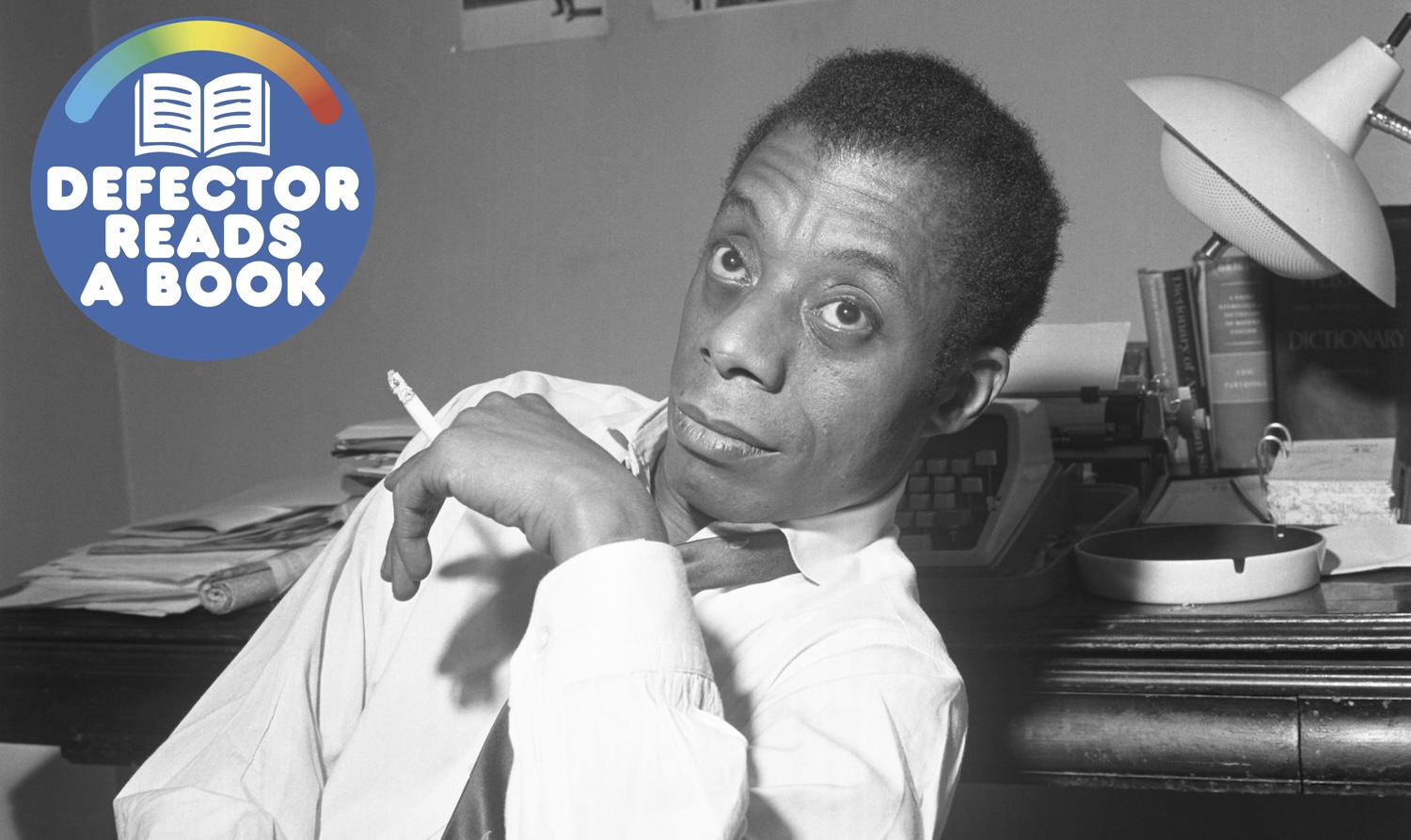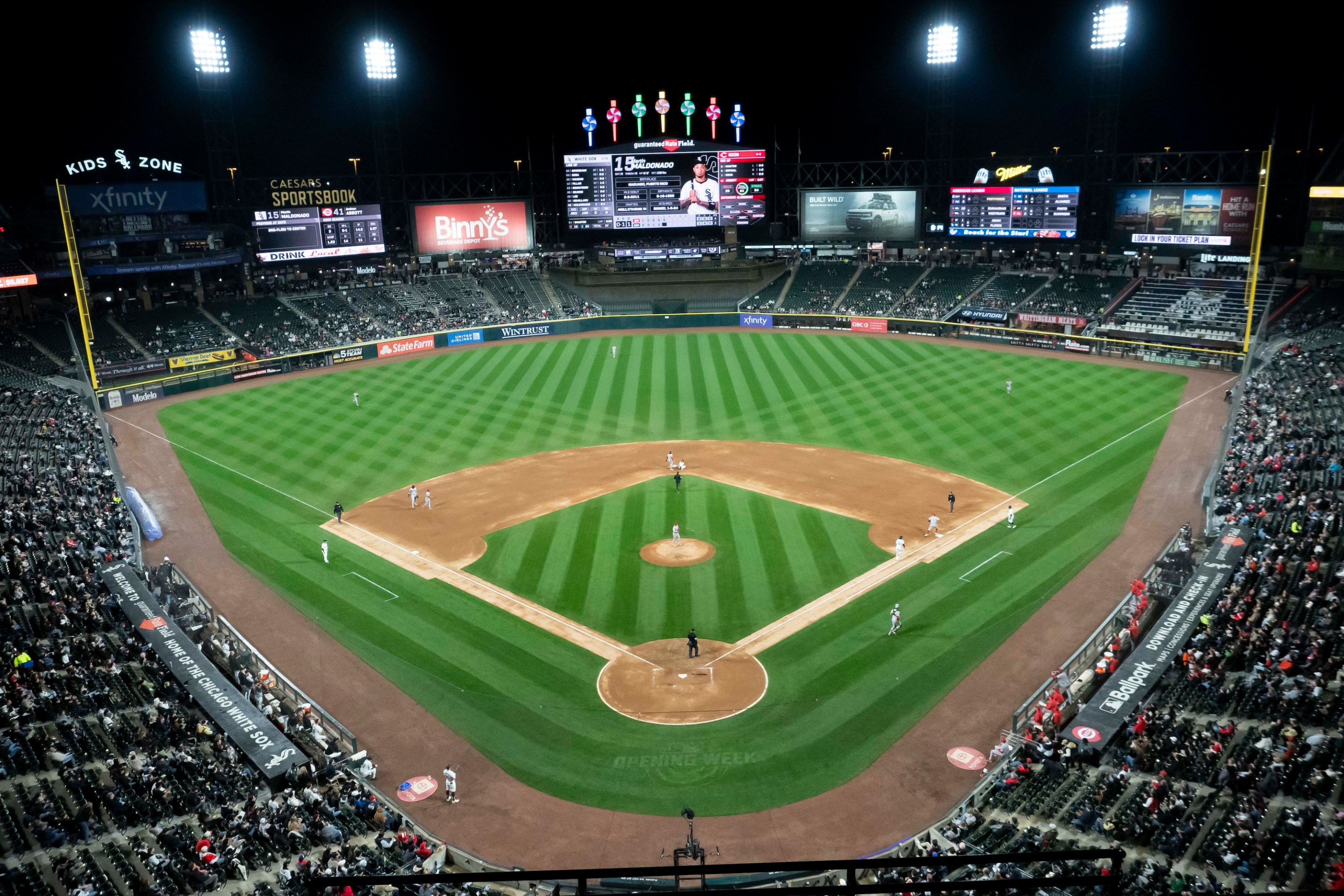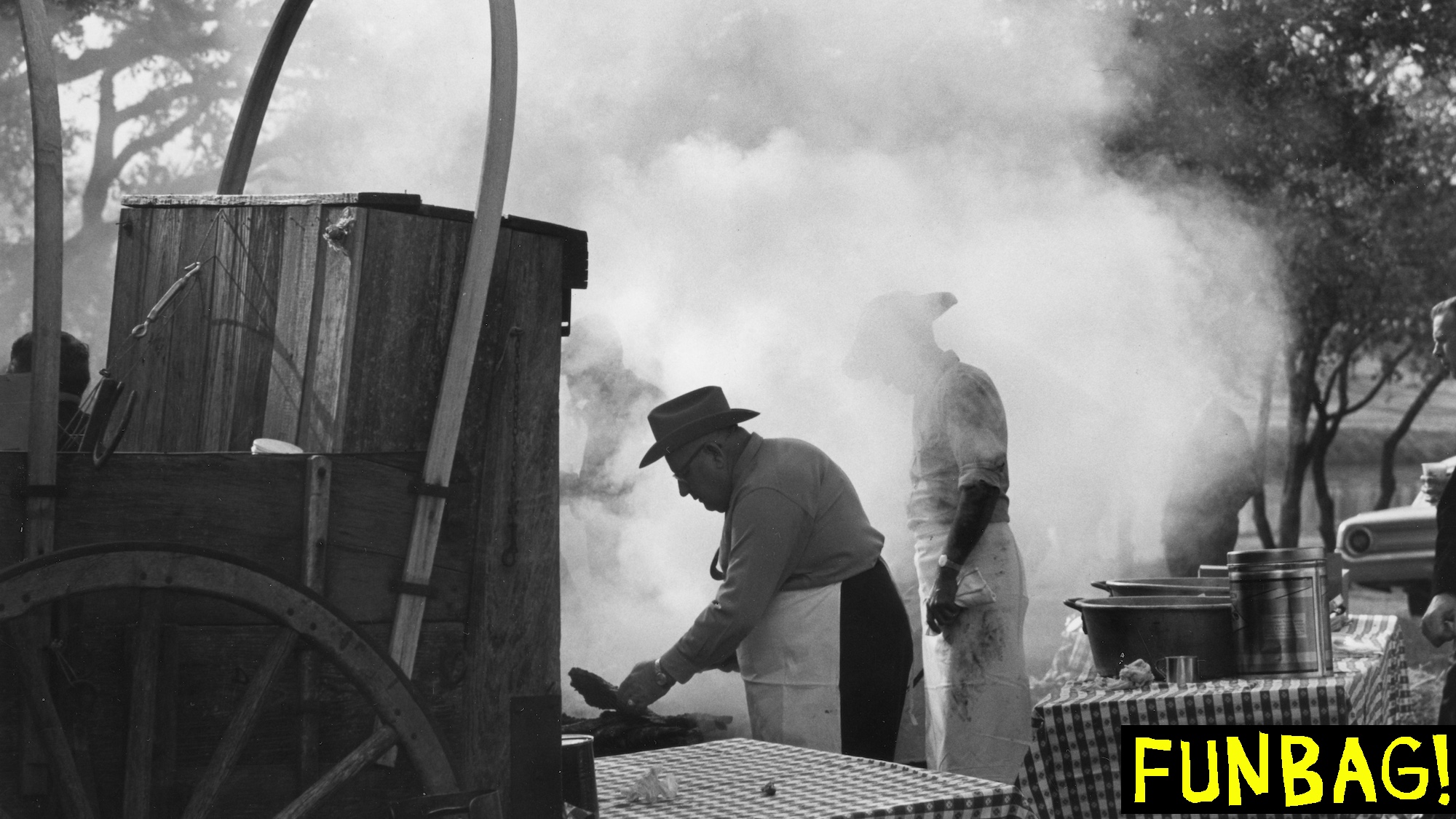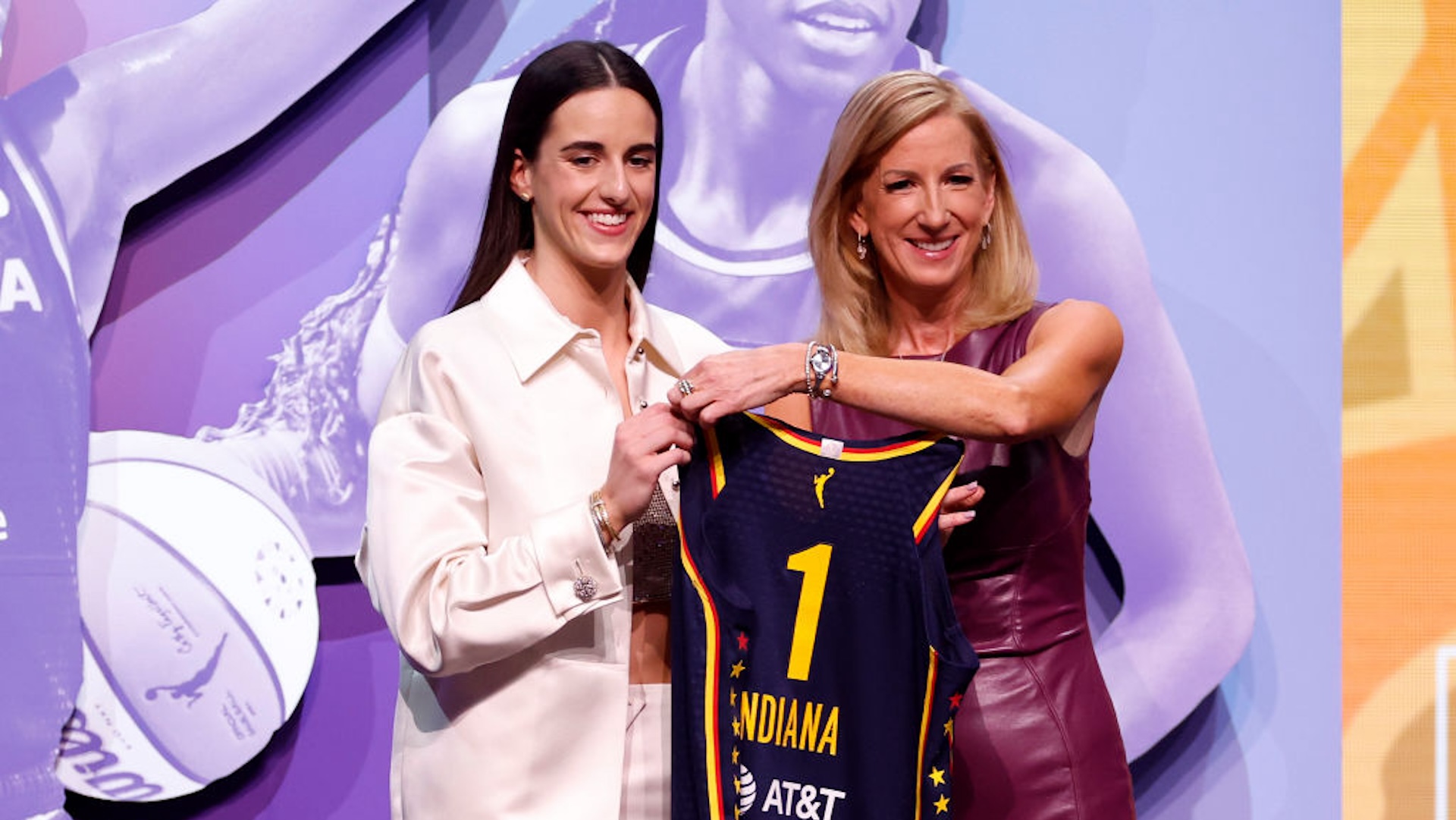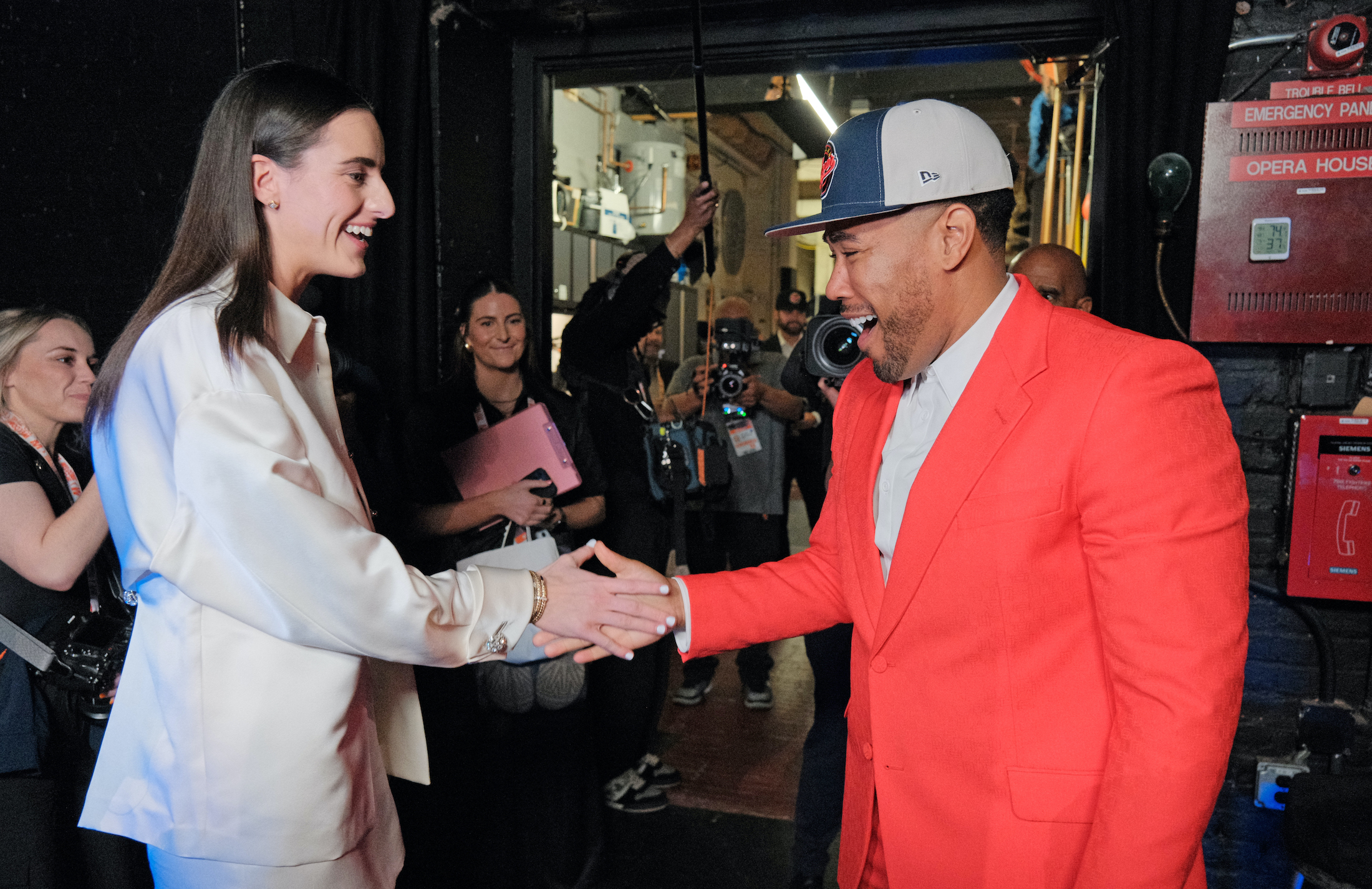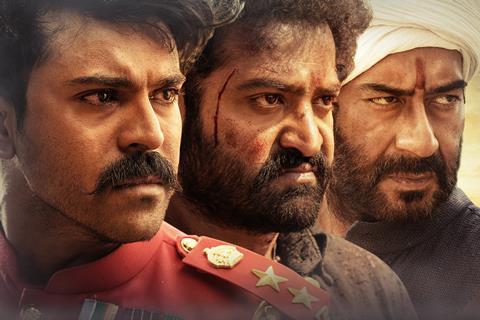
The first time friends and not lovers Raju and Bheem meet, a child is in danger of burning up in flames on a boat in the middle of a river. Raju is on a bridge overlooking the catastrophe and sees Bheem agitated on shore and motions for him to come up. Bheem, without hesitation, jumps on a motorbike (he works in a repair shop), while Raju jumps on a horse (it was attached to an abandoned cart) and grabs a bunch of rope. No one says anything but somehow Raju successfully communicates, through way too few hand gestures, to Bheem that they should both tie opposite ends of the rope around their own waists then advance at top speed towards each other (in the midst of which Raju grabs a flag, which seems weird but stay with me), then, right before they collide, swerve towards the opposite sides of the bridge and dive off. This all goes off without a hitch. As they swing back towards each other, Bheem, in mid-air, scoops up the kid, while Raju, on the other side, drags the flag across the water. Then, I am not kidding, Bheem tosses the kid to Raju (away from the flames) while Raju tosses the wet flag to Bheem. As they swing away from each other, the kid is punted off to safety, while Bheem plunges back into the flames, but, remember, he has the wet flag wrapped around him now. Still, as Raju swings back towards Bheem, he checks to see if his plan worked and, sure enough, Bheem BURSTS through the flames untouched. It’s a South Asian Rube Goldbergian miracle!!! The two men grab each other’s wrists, and, for a moment, they are suspended in mid-air, and so begins one of the greatest (not gay) love stories of all time.
This is perhaps the most spectacular sequence in the Indian blockbuster RRR—RRR being the initials of the stars and the director, but retroactively becoming an acronym for Rise Roar Revolt—but, frankly, it’s hard to choose. Director S. S. Rajamouli’s surprise Western crossover hit is sold as a Telugu language epic action drama, a fictional account of two real revolutionaries, Raju (Ram Charan, potentially the most beautiful man on earth, whose hair barely budges over the entire three hours) and Bheem (a very John Belushi-looking N. T. Rama Rao Jr.), who in the 1920s end up joining forces to fight the British raj and rescue a local girl. But like all great South Asian masala movies, RRR adheres to a principle noted by the friend I watched it with: Why choose one genre when you can do them all?!!! This is action, this is melodrama, this is romcom, this is a prison escape movie, this is a historic epic, this is a religious screed. And like the scene I just described (doing little justice to what I actually SAW), this movie has the kind of domino-style inventiveness Wes Anderson WISHES he could conjure, mixed with MORE THAN ONE scene (including a lengthy bromance montage) in which Bheem carries Raju atop his shoulders. Despite the viral epic dance-off in which the duo’s high-octane moves put a whole bunch of white people to shame, it’s hard to choose which moments are most thrilling here between the superhuman feats of flying, parkouring, and fighting. My friend’s favorite part, for instance, is when Bheem swings a motorbike above his head and chucks it like it weighs little more than a potted plant.
Not only is it rare to see an Indian blockbuster vaunted by American outlets like The New Yorker and The Atlantic, it’s even rarer to see a non-Bollywood film out of India get the kind of traction RRR has gotten among white audiences in the UK, Canada, and even Australia. Siddhant Adlakha, who is from Mumbai—the home of Bollywood—but lives in New York and made a video essay with Patrick Willems about RRR, says Indian films don’t usually get a lot of promotion because the diaspora market is a tight one, with word of mouth spreading quickly. “But this, like, it just kept going and going and going, kept like metastasizing almost,” he tells me. He saw RRR on opening weekend at the end of March with a mostly Telugu audience, but within weeks the crowd was 50-50 brown and non-brown. The movie ended up being re-released on June 1 because of how late so many people came to it. “Even though it’s a mainstream blockbuster in India,” Adlakha explained, “it spread almost like a cult film over here amongst non-Indian audiences.”
RRR’s spread was more certain locally. Tollywood, the name of the Telugu film industry in the south, out of which RRR came, is more ambitious than Bollywood, which has historically claimed the most national attention and financial support, relegating everyone else to regional cinema. At The Takeaway, Adlakha described Tollywood as “Bollywood squared. It’s bigger. The action is way more over the top. The emotion can be even more melodramatic. It’s just more, more, and more.” While Telugu movies are known for their amped-up star power and mix of genres, newer filmmakers like Rajamouli have also improved their storytelling. Industry expert Sangeetha Devi Dundoo told the BBC that Rajamouli changed the landscape due to the “emotional undercurrent of the story and the [fact that] characters drove the action sequences.” While Slate’s Nitish Pahwa forensically broke down RRR’s influences—from Spaghetti-Western style bromance Sholay (1975) to the supermen of Mr. India (1987)—according to S.V. Srinivas, a scholar of South Indian cinema, Rajamouli’s films have “few parallels.” While their themes of oppression and resistance, of Hindu and Muslim fraternity, are present throughout Indian cinema, the narrative of invincible heroes fighting for the common good became a staple of mass audience Telugu films of the 1990s, and with RRR these elements appeal in particular to the rising Hindu nationalist movement in the country.
According to Al Jazeera, Tollywood has now surpassed Bollywood at the Indian box office. This is in large part thanks to Rajamouli’s original breakout feature, which made history thanks to its scope, both financially and linguistically. A two-part pan-Indian film, Baahubali (released in 2015 and 2017) is, a lot like RRR, about a man who helps his lover rescue an imprisoned queen. Made on a budget of $59 million (which is more than double the top end of the average Bollywood blockbuster), it was shot in both Telugu and Tamil and released in dubbed Hindi and Malayalam, meaning not only was it a ramped-up spectacle, it was a ramped-up spectacle with widespread appeal. As such, it ended up bringing in $314 million, making it India’s second most successful film at the worldwide box office and growing Telugu’s box office five-fold. Still, it wasn’t RRR.
Like so many movies during the pandemic, RRR’s release was delayed multiple times, which built anticipation. In the meantime, Western audiences stuck at home and running out of things to watch, started dipping into international cinema. And with the proliferation of superhero tentpoles, extreme spectacle had become more familiar to them. “There’s always been a kind of overlap between the idea of the superhero and the idea of Hindu mythology,” says Adlakha. “And both of those things keep working their way in as influences within big Indian fantasy films, because there is all this exposure from the West from superheroes.” But Western superheroes have become a little (a lot) rote of late. Hollywood blockbusters as a whole, Adlakha notes, have acquired a same-y kind of tongue-in-cheek standard, their action usually pre-conceived. Not only does Rajamouli keep his action closely tied to his character development, he is famous for expertly representing hero worship in such a way as to appeal to the widest possible audience. For instance, the scene in which Raju emerges looking like a golden god with a bow and arrow and a bare chest; the look is that of real-life hero of the jungle Alluri Sitarama Raju. “On one level, if you’re familiar with that imagery, it says one thing,” says Adlakha, “but also, if you’re unfamiliar with it, it’s not like that shot is totally alienating to you, because he does film it with this sort of mythic grandeur.”
When RRR was finally released—the first Indian movie to launch in Dolby in the U.S., opening at over 1,000 locations in five languages—Adlakha thinks that the maximalism combined with the film being so many people’s first exposure to Indian cinema made its impact all the greater. Which is not to say RRR does not deliver on some of the worst elements Western audiences have come to associate with Indian blockbusters. The dialogue can be cheesy, the montages beyond saccharine, and the Greek chorus-style music is often ridiculous; it can be hard to gauge if the acting (especially from the white actors) is campy or just bad; the violence is laughably gross, and the CGI can be atrocious. But the whole thing is so much fun that those elements are swept up into the pageantry. “For a lot of people here they think Indian cinema, ‘Oh, you know, song and dance, over the top, it’s very silly,’” says Adlakha. “And all those things do apply to RRR, but those are no longer things you can dismiss, those are now the highlights.” And because Western audiences are recommending these films, they are making them even more legible, using recognizable comparisons like Rajamouli being the Indian James Cameron. “Folks like me can scream from the rooftops, like, ‘Hey, go watch KGF2, go watch Vikram,’” Adlakha says. “But until it’s, like, a friend of mine Patrick or someone like that, until they start saying like, ‘Oh, yeah, check this thing out that you may not ordinarily check out,’ that kind of gets the ball rolling.” This allows a movie like the one Adlakha mentioned, KGF: Chapter 2, the Kannada-language sequel, to become a near instant hit post-RRR, even exceeding it at a box office, which has become increasingly borderless. As Srinivas put it to me, “This is not about universal themes, but global mass culture. We are all in it together.”
If you liked this blog, please share it! Your referrals help Defector reach new readers, and those new readers always get a few free blogs before encountering our paywall.
Stay in touch
Sign up for our free newsletter
